The Simulation of the Recharging Method Based on Solar Radiation for an Implantable Biosensor
Abstract
:1. Introduction
2. Modeling
2.1. Method
2.2. Solar Radiation Model
2.2.1. Spectral Range
2.2.2. Calculation Method
2.3. Fresnel Lens Model
2.4. Skin Tissue Model
3. Simulations
3.1. Energy Distribution of Sunlight on the Skin Surface
3.1.1. Simulation Condition
3.1.2. Vertical Incidence
3.1.3. Oblique Incidence
3.1.4. Safety
3.2. Energy Distributions within Skin Tissue
3.2.1. Method
3.2.2. Energy Distribution along r Axis
3.2.3. Energy Distribution along z Axis
4. Physical Experiments
4.1. Experimental Device
4.2. Results and Discussions
5. Conclusions
Acknowledgments
Author Contributions
Conflicts of Interest
References
- Carrara, S.; Ghoreishizadeh, S.; Olivo, J.; Taurino, I.; Baj-Rossi, C.; Cavallini, A.; Op de Beeck, M.; Dehollain, C.; Burleson, W.; Moussy, F.G. Fully integrated biochip platforms for advanced healthcare. Sensors 2012, 12, 11013–11060. [Google Scholar] [CrossRef] [PubMed]
- Gaxiola-Sosa, J.E.; Entesari, K. Design and implementation of a wireless medical system prototype for implantable applications. Analog Integr. Circ. Signal Process. 2015, 82, 99–111. [Google Scholar] [CrossRef]
- Song, S.H.; Kim, A.; Ziaie, B. Omnidirectional ultrasonic powering for millimeter-scale implantable devices. IEEE Trans. Biomed. Eng. 2015, 62, 2717–2723. [Google Scholar] [CrossRef] [PubMed]
- Gagnon-Turcotte, G.; Avakh Kisomi, A.; Ameli, R.; Dufresne Camaro, C.-O.; Lechasseur, Y.; Neron, J.-L.; Brule Bareil, P.; Fortier, P.; Bories, C.; Koninck, Y.; et al. Wireless optogenetic headstage with multichannel electrophysiological recording capability. Sensors 2015, 15, 22776–22797. [Google Scholar] [CrossRef] [PubMed]
- O’Sullivan, T.D.; Heitz, R.T.; Parashurama, N.; Barkin, D.B.; Wooley, B.A.; Gambhir, S.S.; Harris, J.S.; Levi, O. Real-time, continuous, fluorescence sensing in a freely-moving subject with an implanted hybrid VCSEL/CMOS biosensor. Biomed. Opt. Express 2013, 4, 1332–1341. [Google Scholar] [CrossRef] [PubMed]
- Song, Y.; Hao, Q.; Kong, X.Y.; Hu, L.X.; Cao, J.; Gao, T.X. Simulation of the recharging method of implantable biosensors based on a wearable incoherent light source. Sensors 2014, 14, 20687–20701. [Google Scholar] [CrossRef] [PubMed]
- Silay, K.M.; Dondi, D.; Larcher, L.; Declercq, M.; Benini, L.; Leblebici, Y.; Dehollain, C. Load Optimization of an Inductive Power Link for Remote Powering of Biomedical Implants. In Proceedings of the IEEE International Symposium on Circuits and Systems (ISCAS 2009), Taipei, Taiwan, 24–27 May 2009; pp. 533–536.
- Lenaerts, B.; Puers, R. An inductive power link for a wireless endoscope. Biosens. Bioelectron. 2007, 22, 1390–1395. [Google Scholar] [CrossRef] [PubMed]
- Majerus, S.; Fletter, P.C.; Damaser, M.S.; Garverick, S.L. Low-power wireless micromanometer system for acute and chronic bladder-pressure monitoring. IEEE Trans. Biomed. Eng. 2011, 58, 763–767. [Google Scholar] [CrossRef] [PubMed]
- Sukwisute, P.; Muensit, N.; Soontaranon, S.; Rugmai, S. Micropower energy harvesting using poly (vinylidene fluoride hexafluoropropylene). Appl. Phys. Lett. 2013, 103, 063905. [Google Scholar] [CrossRef]
- Olivo, J.; Carrara, S.; De Micheli, G. Energy harvesting and remote powering for implantable biosensors. J. IEEE Sens. 2011, 11, 1573–1586. [Google Scholar] [CrossRef]
- Kim, D.H.; Lee, Y.H.; Lee, D.U.; Kim, T.W.; Kim, S.; Kim, S.W. Significant enhancement of the power conversion efficiency for organic photovoltaic cells due to a P3HT pillar layer containing ZnSe quantum dots. Opt. Express 2012, 20, 10476–10483. [Google Scholar] [CrossRef] [PubMed]
- Algora, C.; Pena, R. Recharging the battery of implantable biomedical devices by light. J. Artif. Organs 2009, 33, 855–860. [Google Scholar] [CrossRef] [PubMed]
- Yang, Y.; Wei, X.J.; Liu, J. Evaluation on the power generation capacity of a thermoelectric generator implanted in the biotissue. J. Phys. D Appl. Phys. 2007, 40, 5790–5800. [Google Scholar] [CrossRef]
- Elfrink, R.; Kamel, T.M.; Goedbloed, M. Vibration energy harvesting with aluminumnitride based piezoelectric devices. J. Micromech. Microeng. 2009, 19. [Google Scholar] [CrossRef]
- Ben Amar, A.; Kouki, A.B.; Cao, H. Power approaches for implantable medical devices. Sensors 2015, 15, 28889–28914. [Google Scholar] [CrossRef] [PubMed]
- Gueymard, C.A. Parameterized transmittance model for direct beam and circumsolar spectral irradiance. Sol. Energy 2001, 71, 325–346. [Google Scholar] [CrossRef]
- Bashkatov, A.N.; Genina, E.A.; Kochubey, V.I.; Tuchin, V.V. Optical properties of human skin, subcutaneous and mucous tissues in the wavelength range from 400 to 2000 nm. J. Appl. Phys. 2005, 38, 2543–2555. [Google Scholar] [CrossRef]
- Gordon, H.R.; Mccluey, W.R. Estimation of the depth of sunlight penetration in the sea for remote sensing. Appl. Opt. 1975, 14, 413–416. [Google Scholar] [CrossRef] [PubMed]
- Singh, P.K.; Kumar, R.; Vinod, P.N.; Chakravarty, B.C.; Singh, S.N. Effect of spatial variation of incident radiation on spectral response of a large area silicon solar cell and the cell parameters determined from it. Sol. Energy Mater. Sol. Cells 2003, 80, 21–31. [Google Scholar] [CrossRef]
- Wang, J.; Wang, E.; Yin, H.; Feng, L.P.; Zhao, Y.X. Differences between observed and calculated solar radiations and their impact on simulated crop yields. Field Crop. Res. 2015, 176, 1–10. [Google Scholar] [CrossRef]
- Notton, G.; Muselli, M.; Louche, A. Two estimation methods for monthly mean hourly total irradiation on tilted surfaces from monthly mean daily horizontal irradiation from solar radiation data of Ajaccio, Corsica. Sol. Energy 1996, 57, 141–153. [Google Scholar] [CrossRef]
- Garcia-Uribe, A.; Balareddy, K.C.; Zou, J.; Wang, L.V. Micromachined fiber optical sensor for in vivo measurement of optical properties of human skin. IEEE Sens. J. 2008, 8, 1698–1703. [Google Scholar] [CrossRef]
- Meglinski, I.V.; Matcher, S.J. Quantitative assessment of skin layers absorption and skin reflectance spectra simulation in the visible and near-infrared spectral regions. Physiol. Meas. 2002, 23, 741–753. [Google Scholar] [CrossRef] [PubMed]
- Oh, S.J.; Lee, Y.J.; Chen, K.; Kim, Y.M.; Lim, S.H.; Chun, W. Development of an embedded solar tracker for the enhancement of solar energy utilization. Int. J. Energy Res. 2012, 36, 249–258. [Google Scholar] [CrossRef]
- International Commission on Non-Ionizing Radiation Protection. Icnirp guidelines on limits of EXPOSURE to laser radiation of wavelengths between 180 nm and 1000 μm. Health Phys. 2013, 105, 271–295. [Google Scholar]
- Moritz, A.R.; Henriques, F.C. Studies of Thermal Injury: II. The relative importance of time and surface temperature in the causation of cutaneous burns. J. Am. J. Pathol. 1947, 23, 695–720. [Google Scholar] [PubMed]
- Ahmad, S.; Shafie, S.; Ab Kadir, M.Z.A. A High Power Generation, Low Power Consumption Solar Tracker. In Proceedings of the 2012 IEEE International Conference on Power and Energy (PECon), Kota Kinabalu, Malaysia, 2–5 December 2012; pp. 366–371.
- Genina, E.A.; Bashkatov, A.N.; Kochubey, V.I.; Tuchin, V.V. Effect of storage conditions of skin samples on their optical characteristics. J. Opt. Spectrosc. 2009, 107, 934–938. [Google Scholar] [CrossRef]
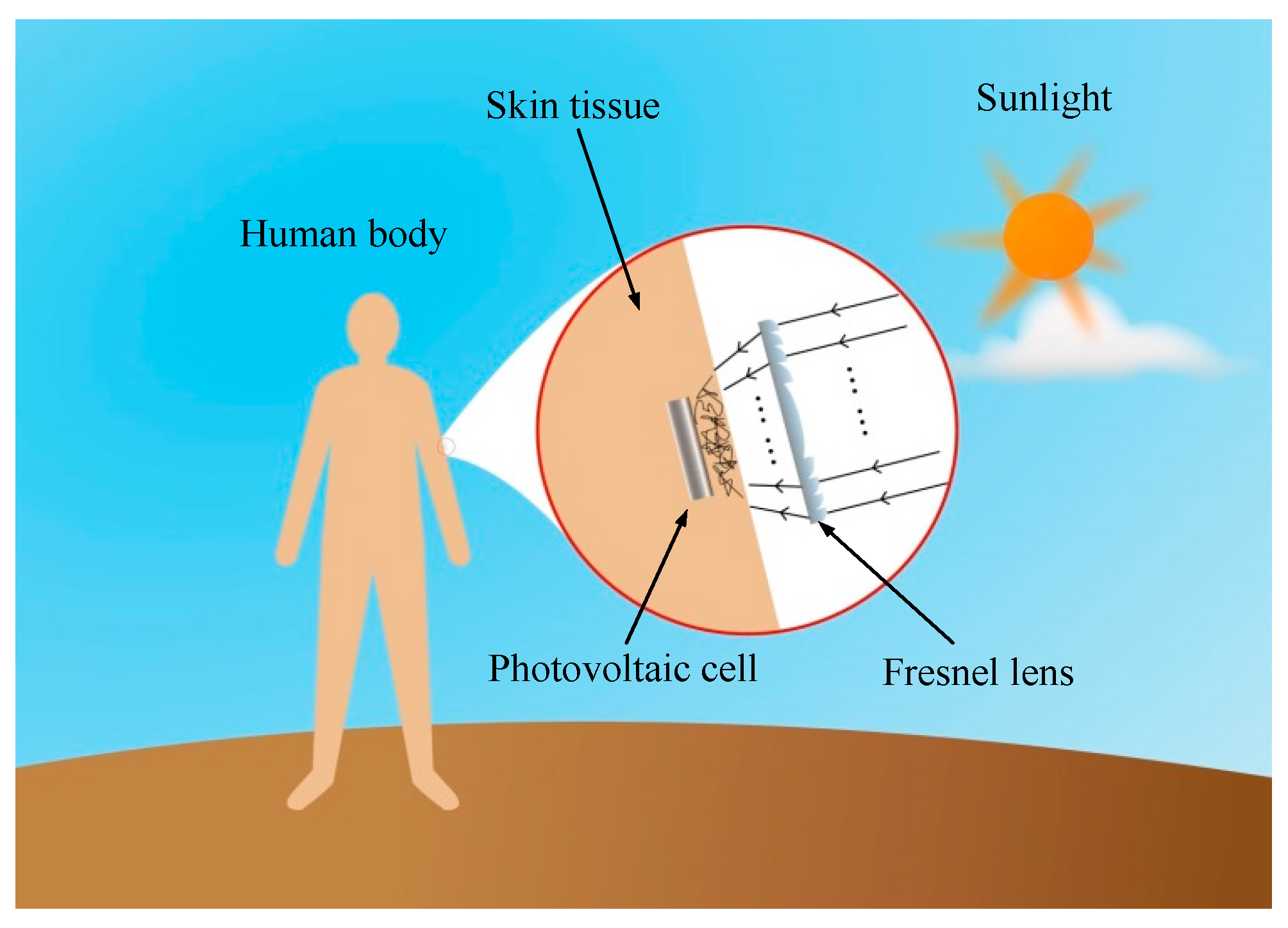
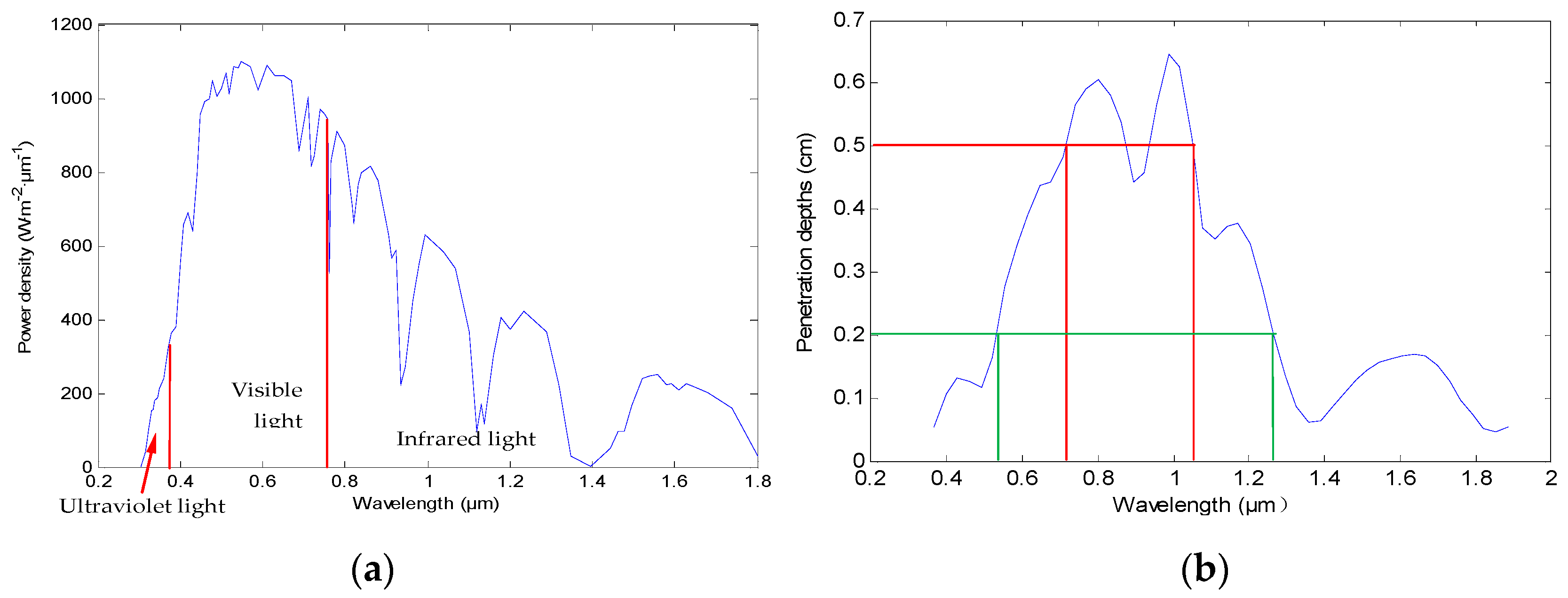

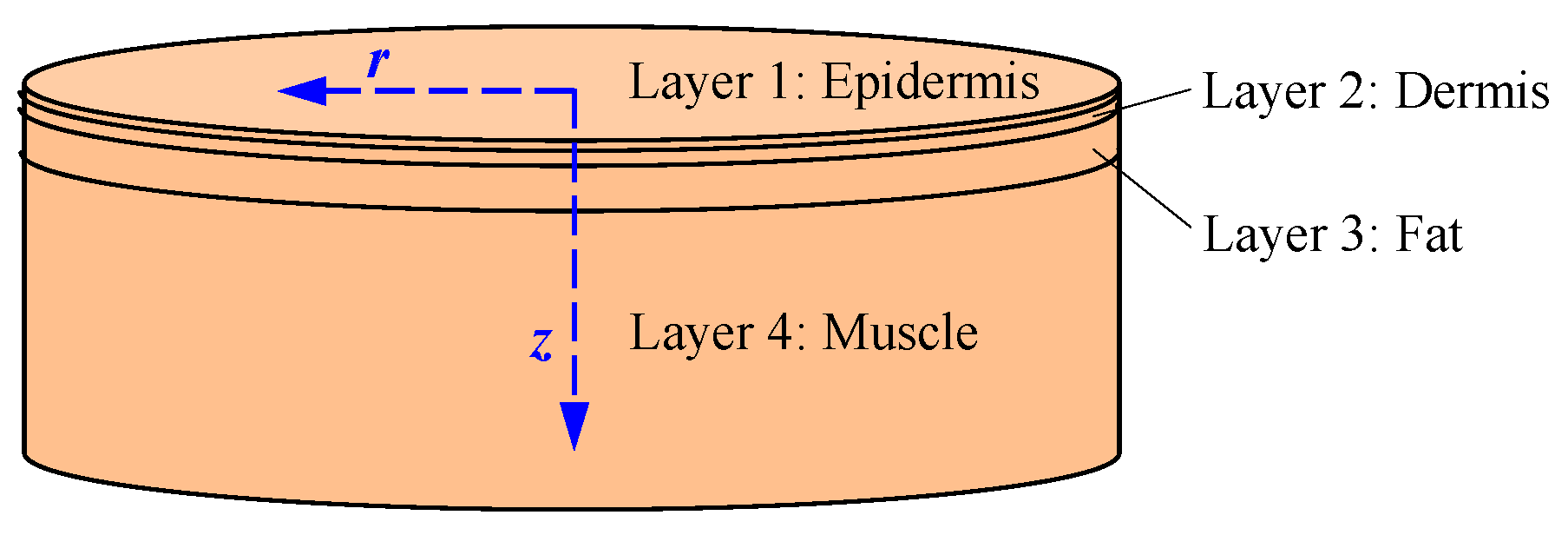
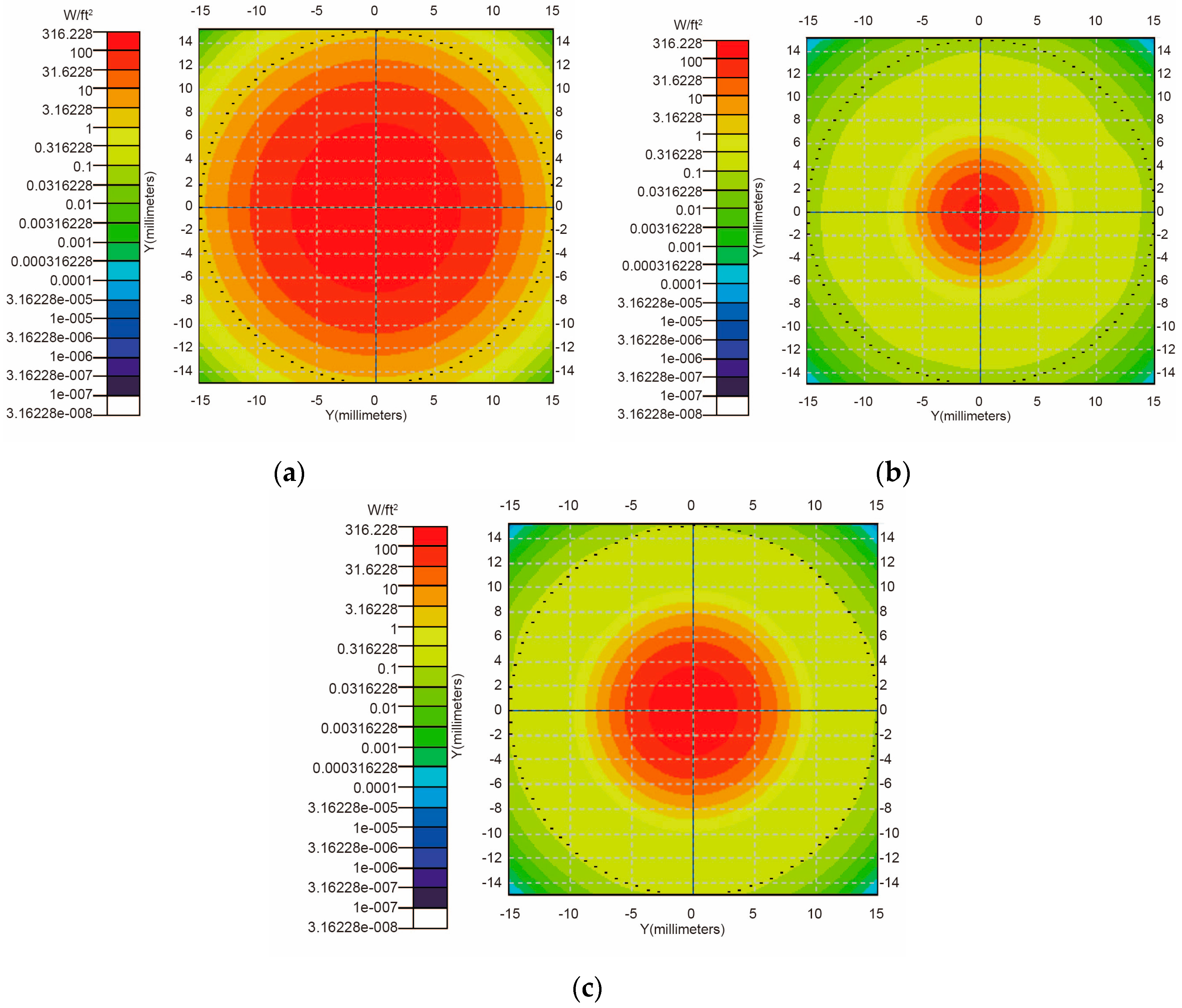

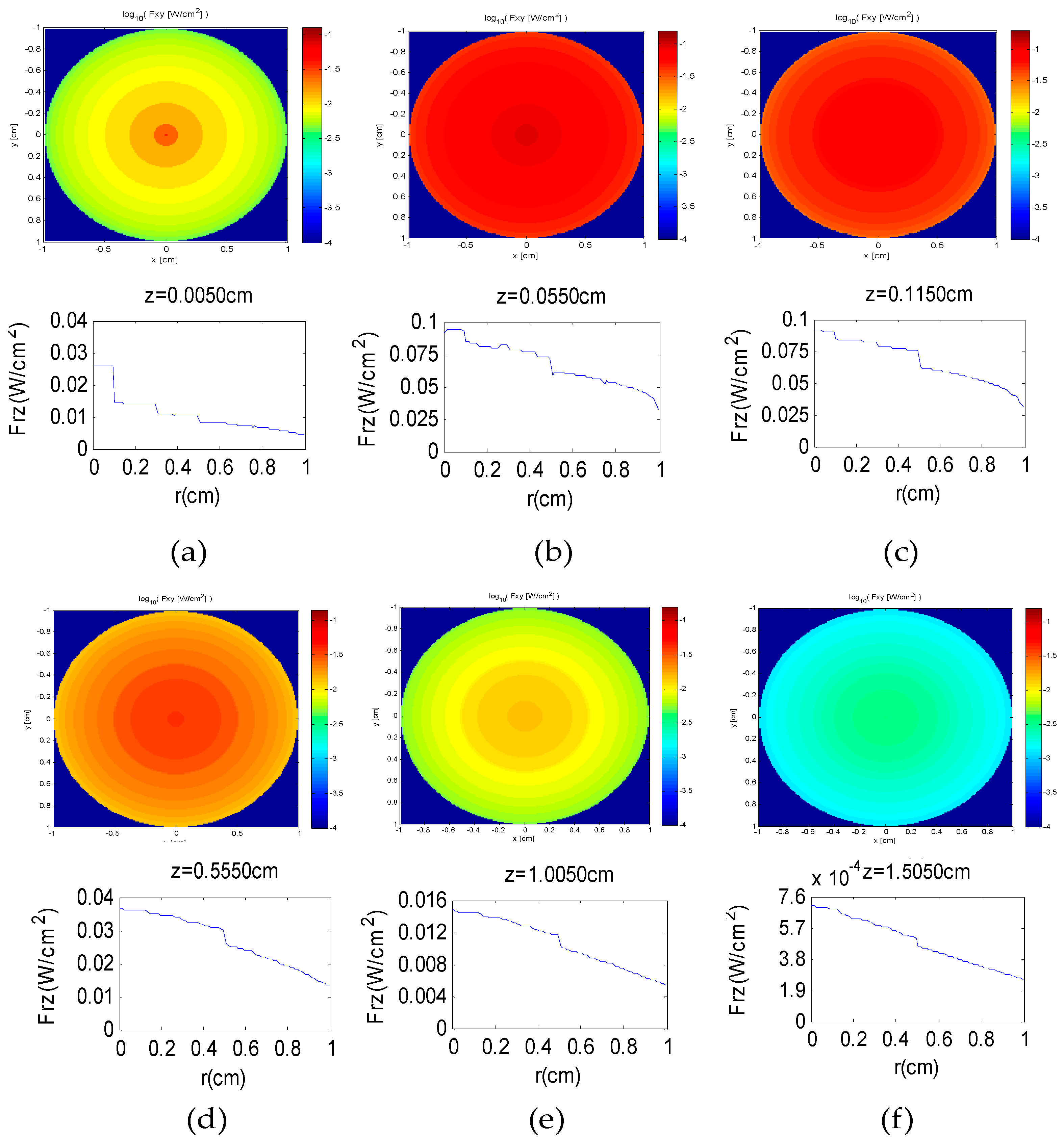
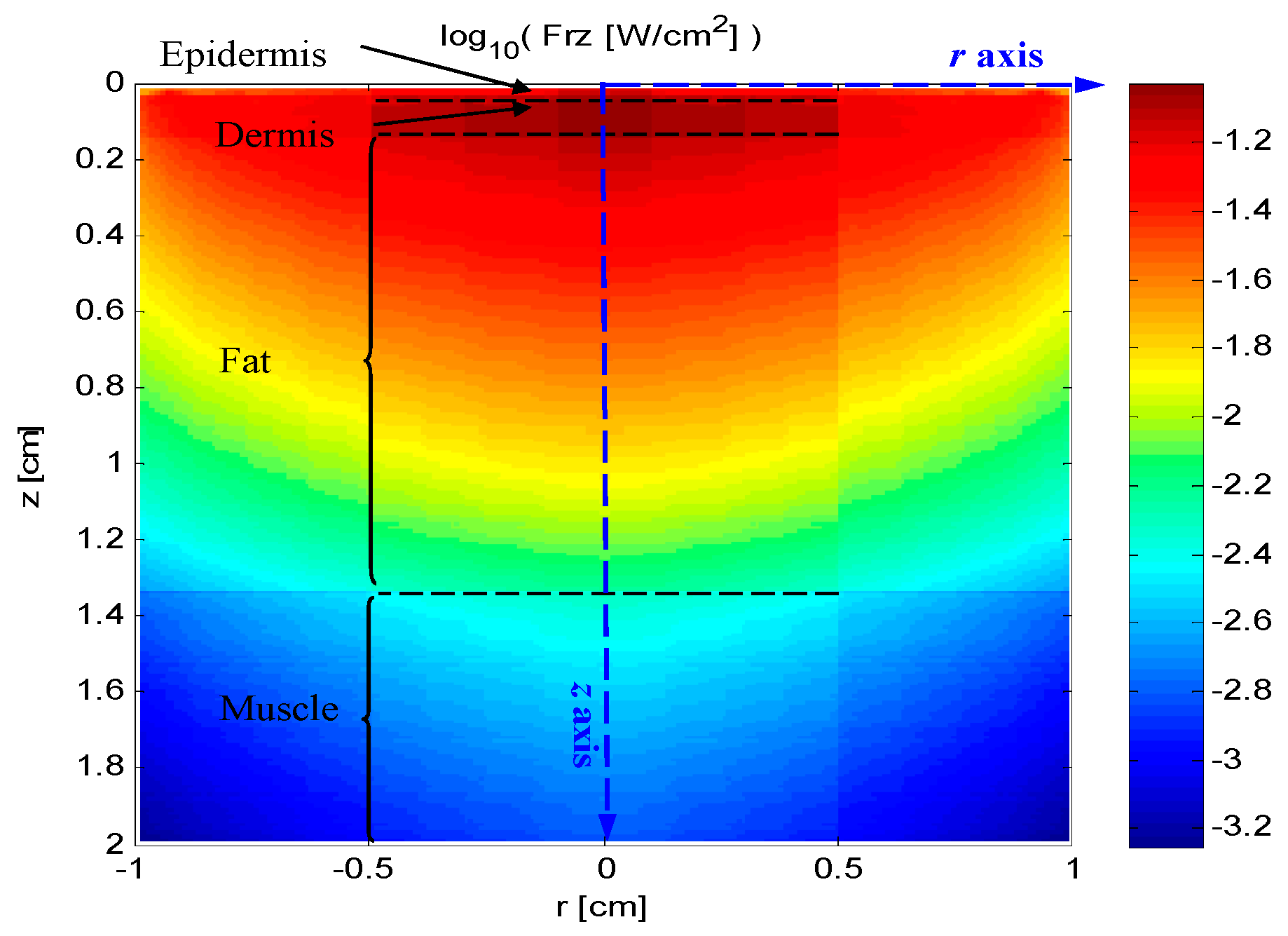
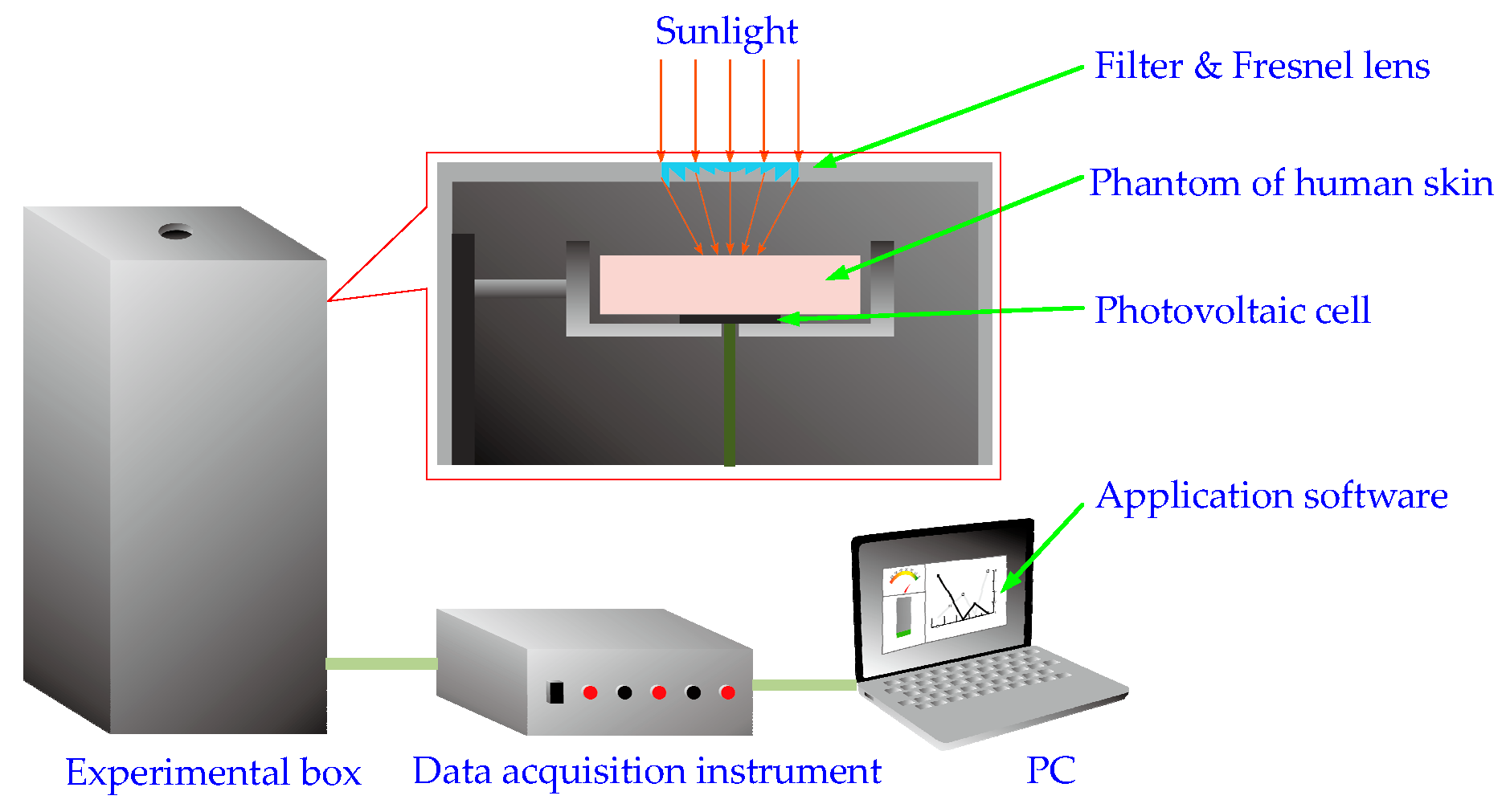
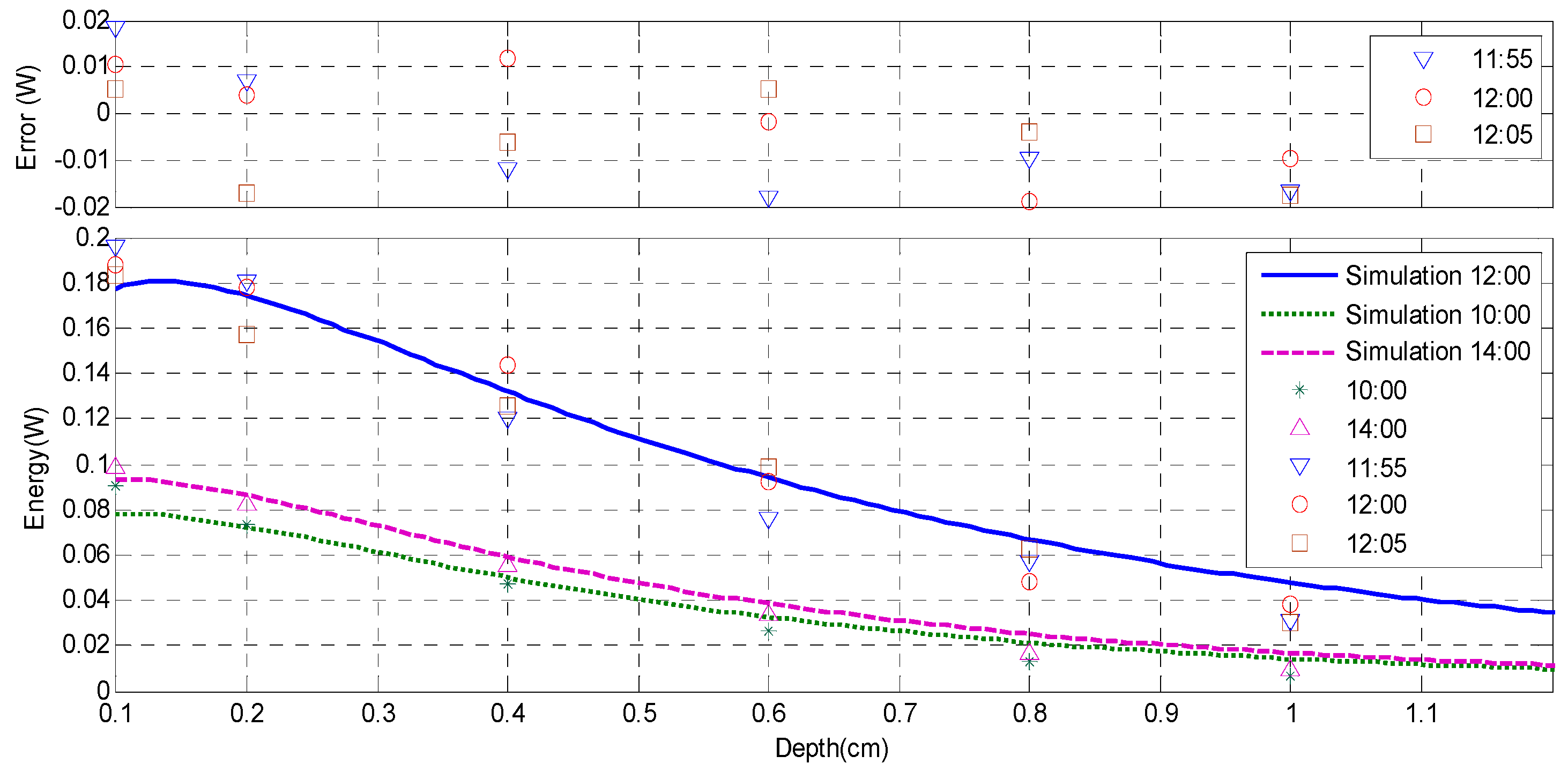
| Methods | Reliability | Cost | Size (cm2) | Received Power (mW) | References |
|---|---|---|---|---|---|
| Radio frequency electromagnetic induction method | Low | Low | Unknown | 10 | [14] |
| Thermo electric generator method | Low | High | 1.0 | 0.001 | [11,15] |
| Previous optical recharging method | Low | High | 10 | 4.00 | [11,16] |
| The proposed recharging method | High | Low | Unknown | 2.8–5.6 |
| Time | Altitude Angle (°) | Azimuth Angle (°) | Incident Energy (W) | Energy on Skin without shift (W) | Energy on Skin after Shift (W) |
|---|---|---|---|---|---|
| 10:00 | 60.01 | 66.59 | 0.347 | 0.0562 | 0.0892 |
| 12:00 | 73.5 | 0 | 0.480 | 0.1494 | 0.1848 |
| 14:00 | 60.31 | −66.60 | 0.433 | 0.0624 | 0.1071 |
© 2016 by the authors; licensee MDPI, Basel, Switzerland. This article is an open access article distributed under the terms and conditions of the Creative Commons Attribution (CC-BY) license (http://creativecommons.org/licenses/by/4.0/).
Share and Cite
Li, Y.; Song, Y.; Kong, X.; Li, M.; Zhao, Y.; Hao, Q.; Gao, T. The Simulation of the Recharging Method Based on Solar Radiation for an Implantable Biosensor. Sensors 2016, 16, 1468. https://doi.org/10.3390/s16091468
Li Y, Song Y, Kong X, Li M, Zhao Y, Hao Q, Gao T. The Simulation of the Recharging Method Based on Solar Radiation for an Implantable Biosensor. Sensors. 2016; 16(9):1468. https://doi.org/10.3390/s16091468
Chicago/Turabian StyleLi, Yun, Yong Song, Xianyue Kong, Maoyuan Li, Yufei Zhao, Qun Hao, and Tianxin Gao. 2016. "The Simulation of the Recharging Method Based on Solar Radiation for an Implantable Biosensor" Sensors 16, no. 9: 1468. https://doi.org/10.3390/s16091468
APA StyleLi, Y., Song, Y., Kong, X., Li, M., Zhao, Y., Hao, Q., & Gao, T. (2016). The Simulation of the Recharging Method Based on Solar Radiation for an Implantable Biosensor. Sensors, 16(9), 1468. https://doi.org/10.3390/s16091468






